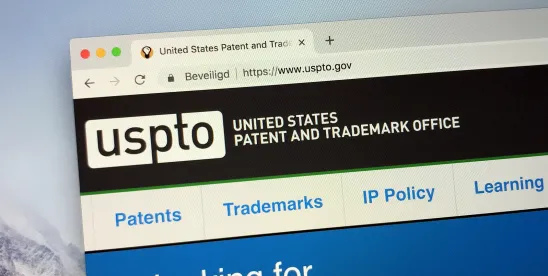We have compiled takeaways from the proposed amendments to the rules of practice, including the proposal and practice tips. Comments on the proposed amendments must be received by the USPTO by July 9, to be considered.
The proposed rule change would require terminal disclaimers filed to overcome non-statutory double patenting to include an agreement that the patent (or application) in which the terminal disclaimer is filed will be enforceable only if the patent/application is not tied (directly or indirectly) to a patent by one or more terminal disclaimers filed to obviate non-statutory double patenting in which any claim has been held unpatentable or invalidate as anticipated or obvious.
Current Practice
The current practice is that patents tied by one or more terminal disclaimers after an obviousness-type double patenting rejection must be separately challenged on validity grounds. The USPTO notes in the proposed rule that “multiple patents tied by terminal disclaimers that are directed to obvious variants of an invention could deter competition due to the prohibitive cost of challenging each patent separately in litigation or administrative proceedings.”
Proposed Rulemaking
The USPTO is proposing to revise 37 CFR §1.321(c) and (d) to require that terminal disclaimers filed to eliminate non-statutory double patenting must include an agreement that “the subject patent or any patent granted on the subject application shall be enforceable only if the patent is not tied and has never been tied directly or indirectly to a patent by one or more terminal disclaimers filed to obviate non-statutory double patenting in which: (1) any claim has been finally held unpatentable or invalid under 35 U.S.C. 102 or 103…by a federal court in a civil action or by the USPTO, and all appeal rights have been exhausted; or (2) a statutory disclaimer of a claim is filed after any challenge based on 35 U.S.C. 102 or 103 to that claim has been made.” However, the new rule does not require an applicant to make a statement regarding conflict claims being patentably indistinct.
Direct v. Indirect Tying
A subject patent or any patent granted on the subject application is directly tied by a terminal disclaimer to another patent when (1) the terminal disclaimer is filed in the subject patent or application and (2) the patent or application issued as the other patent is the reference patent or application identified in the terminal disclaimer. However, this tying is unidirectional and is effective only for the patent with the terminal disclaimer. For example, if a terminal disclaimer is filed in a first patent identifying a second patent as a reference patent, then the first patent is tied directly to the second patent, but the second patent is not considered directly tied to the first. Thus, if a claim in the second patent is found invalid under sections 102 or 103, the first patent may not be enforced. However, if a claim in the first patent is found invalid under sections 102 or 103, the second patent may still be enforceable under the agreement in the first patent’s file history.
A subject patent or any patent granted on the subject application is tied indirectly by two terminal disclaimers to another patent when (1) a terminal disclaimer filed in the subject patent or application identifies an intermediate patent/application as reference patent/application, and (2) terminal disclaimer filed in the intermediate patent/application identifies the other patent/application.
Potential Effect
A motive and potential effect of this proposed rulemaking is to decrease the cost and timeline of challenging patents. The USPTO claims this is to “promote competition by lowering cost of challenging groups of patents” and “more focused claim construction hearings” to result in a faster resolution.
The proposed rule may make it easier to avoid having to challenge multiple patents within the same family. It would also likely streamline the work of the US Patent Trial and Appeal Board (PTAB) by encouraging petitioners to challenge a single or limited number of patents within a patent family, to cause a domino effect where patents tied to an earlier-filed patent become unenforceable if that earlier filed-patent is found invalid.
Practice Tips
If this proposed rule making moves forward, a patent applicant or patent practitioner may want to consider how to avoid being affected by this new rule. The USPTO notes that applicants that do not want to file a terminal disclaimer have multiple options to avoid doing so, including combining patentably indistinct claims into a single application, canceling or amending any claims subject to a non-statutory double patenting rejection, arguing the rejected claims in the application are patentably distinct from the claims in the reference application, and filing a reissue application on the issued patent to add patentably indistinct claims from the later application. In the event the proposed rule is instituted and 37 CFR §1.321(c) and (d) are changed, practitioners may also consider filing more claims in the first nonprovisional application to provoke a restriction requirement, which would trigger the section 121 safe harbor provisions that bar non-statutory double patenting rejections over the earlier application.
Comments on the proposed rule will be accepted through July 9 via the Federal eRulemaking Portal at Regulations.gov (docket number PTO-P-2024-0003).



 />i
/>i

